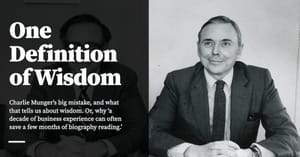There are three kinds of non-fiction book: 💁♀️ narrative, 🌳 tree, and 🌿 branch. (The last two categories are mine, but I needed a catchy name to make this stick.)
"Why is it necessary to categorise non-fiction books?" I hear you asking. Well, I've got an easy answer for that: walk into your nearest book store. What do you see?

Way too many books, that's what.
Categorising the types of non-fiction book helps you with picking books to read. Not every book is worth reading, and not every book should be read the same way. These three categories are the ones that I've found to work best for me — they're not difficult to remember, and they're specific enough to be useful. Here's what each category means:
💁♀️ Narrative Books
Narrative books are books that tell a story. Examples include biographies, memoirs, and histories.
🌳 Tree books
Tree books are books that lay out a framework of ideas. A good example is Daniel Kahneman's Thinking: Fast and Slow, which lays out his life's work — the entirety of behavioural economics — in a single book. (So an entire field, like a tree of knowledge, in one book. Geddit, geddit?) Other books I can think of in this category are High Output Management by Andy Grove, and Principles by Ray Dalio.
🌿 Branch books
Branch books are the most common type of book you'll find in the non-fiction section. These are books that consist of a single idea. The rest of the book is then padded out with examples, extrapolations, and implications of that single idea. A good example of this is Nicholas Nassem Taleb's Antifragile, which can be summarised in a single sentence: "the world consists of systems that are fragile (break easily), robust (are difficult to break) and are antifragile (gets stronger the more you try to break it e.g. like democracy)." The rest of the book explores the full implications of seeing systems as 'fragile/robust/antifragile'.
I've used the term 'tree' and 'branch' because a branch is a subset of a tree. I've often found books on management to be a subset of the framework outlined in Andy Grove's High Output Management, for instance. As a concrete example, the management branch book Radical Candor is simply a detailed examination of ideas that are implied in High Output Management. The ideas in a branch book can often be hung up on the framework developed by a tree book.
Another concrete example: you can hang up pretty much any book by psychologist Dan Ariely on the tree of ideas developed in Daniel Kahneman's Thinking: Fast and Slow.
Ease of summarisation
It's no accident that I summarised Taleb's Antifragile in a single sentence above. The key feature of branch books, for me, is that you can easily summarise them. Which then implies that if someone has written a good summary of a branch book, you can read the summary instead of reading the full book.
This is a useful thing to know. Conversely, tree books and narratives are difficult to summarise. And I'd warn against reading summaries of those books in lieu of reading the actual text: too much gets lost in translation.
The other implication, then, is that services like Blinkist are completely useless for two thirds of the types of books in non-fiction.
Hybrid books
Are these the only kinds of books? Definitely not. There are other books out there that are hybrids: Being Mortal by Atul Gawande is an example of a narrative+branch book (how to die in the modern world, intertwined with the story of his father's death) and Ben Horowitz's The Hard Thing about Hard Things is narrative+tree (the story of his entrepreneurship journey, combined with lessons for CEOs).
But by and large these three categories are all you need. I've decided against adding a fourth category (for technical books, which demand a different approach to reading them). Keeping it to three categories simplifies matters, especially for when you're next in a book store, looking for something to read.
Similarly, not all branch books are bad, and — despite being rarer — not all tree books are good. Some branch books, like The Rise and Fall of American Growth, or The Better Angels of Our Nature, are a tour de force of writing and research, made to advance a single argument.
Reading each kind of book differently
There's another implication here: you can skim branch books. You shouldn't skim narratives and tree books.
With tree books in particular, I find that slowing down to reflect on each chapter to be incredibly rewarding, so long as the tree book is a good one.
But branch books: man. It's absolutely possible to skim branch books while still maintaining an optimal amount of learning.
Peter Bregman explained how to accomplish this in his Harvard Business Review article back in 2016. To summarise:
- Check out the author’s bio online to get a sense of the person’s bias and perspective.
- Read the title, subtitle, front flap, table of contents. Figure out the big-picture argument of the book, and how that argument is laid out.
- Read the introduction and conclusion word for word to figure out where the author starts from and where he eventually gets to.
- Read/skim each chapter: Read the title, the first few paragraphs or the first few pages of the chapter to figure out how the author is using the chapter and where it fits into the argument of the whole book. Then skim through headings and subheadings to get an idea of the flow. Read the first sentence and last sentence of each paragraph. Once you get an argument, feel free to move on to the next argument, skipping over the many repeated case studies or examples.
- End with the table of contents again, looking through, and summarising each.
I've had friends who have told me that they've found many non-fiction books infuriating: "the author repeats himself way too much!" or "I got the point a chapter in, and every subsequent chapter just drove the point home needlessly."
They're not wrong; they're simply reading a bad branch book. My personal suspicion is that badly written branch books are a reflection of the thought-leader-speaker industry. These authors have one good idea, and need to pad out 200 pages of paper in order to gain access to the highly lucrative world of conference speaking.
The best approach with these kinds of books are to: buy them second hand, read them quickly, or to read a summary ... which is to say: to not read them at all.
Update, 10 June 2023: There is one caveat to the ‘branch books are highly summarisable’ idea: in order to understand or use certain concepts, you often have to see varied examples of the concept in action in real world, messy situations. So branch books may well be easily summarisable, but that doesn’t mean you get to skip the hard work of working out all the implications, or collecting multiple instantiations of the concept in action. For more information, see the Learning in Ill-Structured Domains series.
Originally published , last updated .





